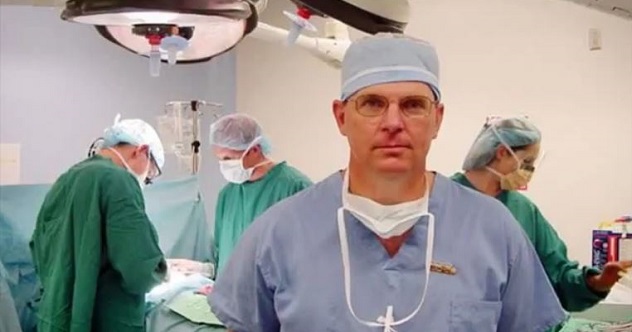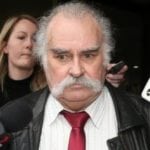 History
History  History
History  Animals
Animals Ten Times It Rained Animals (Yes, Animals)
 Mysteries
Mysteries 10 Devastating Missing Child Cases That Remain Unsolved
 Creepy
Creepy 10 Scary Tales from the Middle Ages That’ll Keep You up at Night
 Humans
Humans 10 One-of-a-kind People the World Said Goodbye to in July 2024
 Movies and TV
Movies and TV 10 Holiday Movies Released at Odd Times of the Year
 Politics
Politics 10 Countries Where Religion and Politics Are Inseparable
 Weird Stuff
Weird Stuff 10 Freaky Times When Famous Body Parts Were Stolen
 Miscellaneous
Miscellaneous 10 Interesting Things Manufacturers Stopped Making and Why
 Gaming
Gaming 10 Funny Tutorials in Games
 History
History 10 Desperate Last Stands That Ended in Victory
 Animals
Animals Ten Times It Rained Animals (Yes, Animals)
 Mysteries
Mysteries 10 Devastating Missing Child Cases That Remain Unsolved
Who's Behind Listverse?

Jamie Frater
Head Editor
Jamie founded Listverse due to an insatiable desire to share fascinating, obscure, and bizarre facts. He has been a guest speaker on numerous national radio and television stations and is a five time published author.
More About Us Creepy
Creepy 10 Scary Tales from the Middle Ages That’ll Keep You up at Night
 Humans
Humans 10 One-of-a-kind People the World Said Goodbye to in July 2024
 Movies and TV
Movies and TV 10 Holiday Movies Released at Odd Times of the Year
 Politics
Politics 10 Countries Where Religion and Politics Are Inseparable
 Weird Stuff
Weird Stuff 10 Freaky Times When Famous Body Parts Were Stolen
 Miscellaneous
Miscellaneous 10 Interesting Things Manufacturers Stopped Making and Why
 Gaming
Gaming 10 Funny Tutorials in Games
10 Doctors Who Saved The Day In Dramatic Fashion
House calls notwithstanding, doctors ideally operate within the confines of a well-run medical facility. Unfortunately, life has a knack for pitching situational curveballs that force physicians to work under difficult, or even life-threatening, conditions. Here are 10 instances when doctors managed to knock those curveballs out of the park.
10 Jeremy Kilburn

In 2012, paramedic Tony Stanley was attempting to airlift an injured man from a hiking trail when a surprise came crashing down on his head. While exiting a rescue helicopter, a propeller blade thwacked him in the back of the noggin. The top of Stanley’s cranium appeared to be leveled, and he was gushing blood. Fortunately, an Air Force doctor named Jeremy Kilburn was already in the area. Unfortunately, Kilburn was the man Stanley had been sent to rescue.
Kilburn had royally wrecked his ankle while hiking to Northern California’s Big Bear Lake. A collision with his dog had caused Kilburn to land awkwardly on his left leg, snapping the ankle. His best friend, Dan Grasso, swiftly discerned that Kilburn needed airborne assistance to get off the trail. Luckily, a passing group of campers happened to have a CB radio that could be used to call for help. Everything seemed to be going smoothly . . . until Stanley’s ill-timed date with a rotary wing.
Dr. Kilburn immediately kicked into medical mode, and he somehow ambled down the hill with his friend, Grasso. A concerned camper had done their best to stem the blood flow from Stanley’s head, but the paramedic was still in rough shape. The Air Force doctor took over, fighting off his own agony to keep his would-be rescuer alive long enough for the rescue pilot to transport both injured men to the hospital.
9 Khurshid Guru
Commercial air travel is rife with pitfalls. For starters, luggage can get lost, sedentary passengers can develop blood clots, or the aircraft could end up in a fiery heap. But for one couple on an Air Canada flight from Spain to the US, their greatest concern revolved around their asthmatic young son.
The toddler had come down with a cold, and about four hours into the flight, his lungs went haywire. His parents, however, had erroneously packed the child’s asthma medication in the checked baggage, meaning there was little they could do.
At this juncture, another passenger stepped in to set things right. That Good Samaritan was none other than the director of robotic surgery at Roswell Park Cancer Institute, Dr. Khurshid Guru. Dr. Guru grasped the urgency of the situation and began tending to the oxygen-starved child as best he could. Things didn’t look good, though.
The plane only had an adult inhaler on hand, which may have been too sophisticated for the ailing toddler to use. His declining oxygen levels, however, necessitated immediate action. The preferable solution would have been to use a nebulizer, but since none were available, Guru created one from scratch. Khurshid cobbled a nebulizer together with a cut-up water bottle, a drinking cup, and an oxygen mask, making it possible to supply the toddler with oxygen from a tank and medication from the inhaler.
By the flight’s end, the child was not only stable but playing with his mom. And as for Dr. Khurshid, ABC labeled him a “medical MacGyver.”
8 William Angus Wallace

Those unfamiliar with William Angus Wallace might think we’re referencing a beefy, Scottish freedom fighter. But the William Wallace we have in mind earned public acclaim in the mid-1990s by using his quick thinking and engineering aptitude to help save a critically wounded woman during a flight from Hong Kong to London.
British Airways passenger Paula Dixon had taken a nasty spill in transit to the airport. The fall broke some of Dixon’s ribs, which in turn collapsed her left lung. Air from her damaged lung began forming a deadly pocket in Paula’s chest, something known as a pneumothorax. But the gravity of her situation went unrecognized until she was already in the air.
Thankfully, Dixon had missed her scheduled departure, forcing her to hop on a flight with not one but two doctors. One of them was Scotland-based practitioner Tom Wong. The other was Dr. Wallace, an orthopedic surgeon based in Nottingham. The doctor duo rushed to Paula’s aid after her left forearm unexpectedly ballooned. They initially surmised that she had simply broken her arm and applied a splint.
Within an hour, however, Paula’s health took a turn for the frightful. She doubled over with extreme chest pain, and Dr. Wallace once more attempted to treat her. Only this time, he noticed that her windpipe was out of place. Soon, the true nature of her health was clear.
Dixon’s air-filled chest needed to be drained, but Dr. Wallace lacked the proper apparatus to do it. He did, however, have a brilliant brain and a few useful items. Armed with an Evian water bottle, oxygen mask tubing, a coat hanger, and Sellotape, William produced a makeshift trocar and draining tube. After disinfecting Dixon’s chest with brandy and anesthetizing her with heart medication, he grabbed a scalpel and went to work.
William’s imaginative gamble paid off, and Paula was right as rain within 15 minutes. Dr. Wallace would later influence air safety as the innovator of the “brace position,” the impact-reducing posture all airline passengers are instructed to adopt in case of an impending crash.
7 Zenko Hrynkiw
In January 2014, Jack Frost and Murphy’s law seemingly conspired against a rapidly deteriorating patient at Birmingham’s Trinity Medical Center. This Alabama patient was in dire need of emergency brain surgery. Without the operation, there was a 90 percent chance of death. Unfortunately, the one man qualified to perform the procedure, Dr. Zenko Hrynkiw, was stuck at a hospital 10 kilometers (6 mi) away.
Making things worse, the icy wrath of winter was bearing down on Birmingham. A ferocious snowstorm had rendered the roads nigh impassable. But Hrynkiw was hell-bent on reversing his patient’s ill fortune.
Undeterred by the inclement weather, Dr. Hrynkiw trudged through torrential ice and snow, wearing nothing but a coat and hospital scrubs. Over the course of his incredible trek, the 62-year-old surgeon tumbled down a hill, but he managed to pick himself back up and press on. Along the way, he also aided a stranded motorist. When he was about 8 kilometers (5 mi) into his frostbitten journey, Dr. Hrynkiw finally hitched a ride to the hospital.
After completing his trial by blizzard, Zenko successfully completed emergency surgery. Afterward, he proceeded to downplay the hellacious effort it took to pull it off. When interviewed about his wintertime heroics, he dismissed his actions as unremarkable. In Dr. Hrynkiw’s words, “It really wasn’t that big of a deal.” But to the patient whose life Zenko had saved, the physician’s epic journey made all the difference in the world.
6 Christine Bradshaw
Eight years before Dr. Hrynkiw’s heroics, winter weather tested the resolve of another brave physician, this time on the Scottish island of Hoy. A 15-meter (50 ft) wave had wiped out a Singaporean tanker, critically injuring several crewmen. Two of the men would perish on the vessel. The third would have met the same fate if it weren’t for an intensive care physician named Dr. Christine Bradshaw.
As powerful winds raged at 130 kilometers per hour (80 mph), Dr. Bradshaw agreed to be lowered by helicopter onto the slippery, wet roof of the tanker’s bridge. As Christine cautiously made her way to the seriously wounded man, the ship violently pitched from side to side. Christine was knocked back and forth as she tried to navigate the boat with stretchers and other medical implements in hand.
The healthier crew members on board tried to help Dr. Bradshaw as she toiled away, but she stood alone as the sole medical expert among them. And the weather only worsened as she worked. Despite these nightmarish impediments, the physician rose to the occasion. After she worked her magic, the wounded man was airlifted to an onshore infirmary.
Thankfully, Dr. Bradshaw’s daring feat didn’t go unnoticed. In 2007, she became a recipient of the Royal National Lifeboat Institute’s bronze medal for gallantry.
5 Melissa Kohn And Megan Stobart Gallagher

Generally speaking, the words “train” and “amputation” should never belong in the same sentence. But in the event of a freak accident, the former sometimes necessitates the latter. Such was the case for a 46-year-old man who lost a decidedly one-sided fight with a freight train in July 2015. He was struck at 2:30 AM at a Philadelphia intersection, and to add callous insult to concussive injury, one of his legs was sandwiched under the train. Amputation was the only way to save him.
A surgical team from Einstein Medical Center was dispatched to the scene. Doctors Melissa Kohn and Megan Stobart Gallagher had the dubious honor of severing the patient’s mangled leg at the ankle. Having to perform a major operation in the field would have been hectic enough, but Kohn and Gallagher had to contend with an another setback. The surgery had to be performed directly beneath the locomotive’s piping hot engine . . . while lying down. It was a claustrophobic operating theater that Kohn estimated to be hotter than 38 degrees Celsius (100 °F).
After 40 minutes of concerted cutting, the doctors had successfully liberated their patient from the freight train’s oppressive grip.
4 Stuart Philip And The Anonymous Urologists

In 2011, a urology conference in Christchurch, New Zealand, was halted in it tracks by the fury of a massive earthquake. The quake obliterated the nearby Pyne Gould building, inciting a number of the conference-goers to seek out victims. Among the impromptu search party were two unnamed doctors and Australian urologist Stuart Philip, three heroes who spent five hours clawing through debris to reach a man buried under the rubble.
The man’s legs were inextricably wedged under a fallen beam, making amputation the sole means of saving his life. Unfortunately, the three urologists weren’t equipped with surgical equipment. Their only available tools were a hacksaw and a Swiss Army knife, courtesy of nearby tradesmen.
Given the circumstances, these would have to do.
One of the unnamed urologists, an anesthetist, had morphine and ketamine on hand, drugs which served as crude sedatives. The other unnamed doctor, a woman small enough to squeeze into the operating space, spent 15 minutes sawing the patient’s legs off above the knee. The process utterly traumatized her. Afterward, Dr. Philip helped lower the man to safety.
On the way to the hospital, another complication emerged as the recently freed man went into cardiac arrest. Thankfully, the doctors were present to administer CPR and sustain him until reaching the medical facility, averting a horrible tragedy.
3 Rachel Tullet

“It looked like a tsunami. My first thought was this could kill me.”
Those were the thoughts racing through the mind of Christchurch physician Rachel Tullet as she raced into the path of an advancing avalanche. The icy onslaught had been triggered by a cataclysmic earthquake in Nepal, a disaster that left more than 8,000 people dead in 2015.
Dr. Tullet, an expert in emergency and wilderness medicine, had traveled to Nepal to volunteer her services to climbers seeking to conquer Mt. Everest. But things took an unexpected turn when the region was struck by a nearly 8.0-magnitude quake. At the time, Tullet was in a medical tent at the mountain’s base. When she heard the ominous rumblings of an avalanche, Rachel responded by scurrying into harm’s way, hoping to warn endangered climbers. But in a matter of seconds, the white wave hurled Dr. Tullet against a rock.
The bone-on-stone collision fractured Rachel’s kneecap, tore her ligaments, and left her with a huge gash in her leg. But rather than harp on her hardship, the doctor turned her attention to the 25 other people injured in the disaster. Somehow, she managed to walk without the aid of pain medication, using a trekking pole for support. Aided by a fellow medic, she organized a rough-and-ready clinic. She administered aid to the wounded, identified the dead, and oversaw the transport of stretcher-bound patients to safety.
Of the multitude that Dr. Tullet helped treat, only two died once out of her care. The morning after the avalanche, Rachel patched up her own wounds, again without the benefit of pain medication. In the aftermath of the ordeal, she remained consummately modest, but witnesses praised her selfless dedication and credited Dr. Tullet with saving nearly two dozen lives.
2 David Tuggle And Andy Sullivan

In 1995, Oklahoma City, Oklahoma, trembled for reasons unrelated to plate tectonics. At the epicenter of the chaos was serviceman-turned-terrorist Timothy McVeigh. On April 19, McVeigh loaded a rental truck with fertilizer, diesel fuel, and other explosive substances, and then set off for the Alfred P. Murrah Federal Building. There, he snuffed out 168 lives and injured more than 500 others.
While McVeigh was busy ending lives, pediatric surgeon David Tuggle (pictured above) was trying to save them at a local hospital. David witnessed the first youngsters being rushed to the emergency room with shattered bones and exposed organs. As the severity of the situation became clear, Dr. Tuggle and physician Andy Sullivan asked law enforcement to taxi them to ground zero.
The doctors were floored by the destruction they saw. However, they didn’t delay in joining the rescue effort. As they surveyed the area, the pair began treating Daina Bradley, a woman who tragically lost her children and grandmother in the blast. Bradley herself was trapped in a small hole on the first floor. Her right leg was lodged under a support column that was holding up the rest of the building. Try to move it, and everything would collapse. The doctors would have to remove the leg.
What should have been a speedy endeavor was protracted by numerous obstacles. For starters, a bomb scare delayed the rescue by an hour. Dr. Sullivan took advantage of the time gap by acquiring medical supplies. Once the operation started, Dr. Tuggle had to repeatedly crawl in and out of a miniscule opening to reach Daina. Then there was the matter of equipment. The amputation knife was too long for the operating space, so David had to rely on disposable scalpels that dulled during surgery. He was forced to finish with a pocketknife.
Even with these difficulties, the efforts of Tuggle and Sullivan prevented Daina Bradley from becoming the Oklahoma City bombing’s 169th fatality.
1 Syria’s Underground Doctors
Since the first shots of civil war rang out in 2011, Syria has been a hub of profound suffering. The conflict has claimed more than 250,000 lives and rendered more than 10 million Syrians homeless, including over four million refugees. As the al-Assad regime has battled with insurrectionists for dominance, civilian deaths have become just as much a goal as a side effect. Professional life-savers have also become prime targets. Hundreds of physicians suspected of aiding Syrian rebels have felt the murderous ire of government forces or have been thrown behind bars and tortured.
Such atrocities have sparked a mass medical exodus, with many practitioners taking the practical step of leaving Syria for their own safety. But some doctors have mobilized in an international effort to heal Syria’s sick and wounded, despite the monumental risks. Physicians from around the globe have run toward the bloodshed, erecting covert clinics and hospitals amid the bombs and bullets.
Some hospitals have been more or less formal undertakings, such as a field hospital established by Doctors Without Borders in 2012. Manned for two months by practitioners from Denmark, Australia, and France, it operated in a clandestine location, with the knowledge of the Syrian government. Other medical facilities, however, have flown completely under the radar. They operate without funding, electricity, or even fixed locations. Such is the case for a cadre of Chicago doctors who run roving underground clinics in hard-hit cities like Aleppo.
These courageous Chicagoans hail from the Syrian American Medical Society, a group dedicated to serving the helpless. These physicians smuggle medical supplies into the country and set up clinics capable of being relocated at a moment’s notice. Physicians treat countless horrific injuries without the luxuries of anesthetics or power. After dark, surgeries are illuminated by the beam of a flashlight.
Topping off these abysmal conditions, underground doctors are constantly under threat from stray gunfire, rockets, and targeted attacks. Their amazing dedication to saving lives in a valley of death is proof that superheroes exist in Syria, but instead of wearing bright red capes, they proudly display their stethoscopes.








